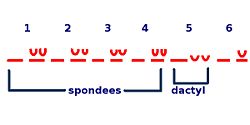Spondee
A spondee in epic poetry is a dactyl in which a poet has switched in a pair of short syllables for a single long syllable in an allowable substitution known as contraction, so that a dactyl becomes a spondee. Epic poetry considered the beats and rhythms of words as well as accents and syllables in poems such as the Iliad and Odyssey by Homer and in the Aeneid by Virgil in deciding which words to pick and how to place them strategically in a line of verse for maximum effect. In English, a dactyl would sound like dum dum while a spondee would sound like dum ditty. A spondee was an allowable convention in hexameter verse since it enabled more possibilities for word choices to fit the rather exacting rules of dactylic hexameter. Every foot in a hexameter verse has the potential to be either a dactyl or a spondee, although there are customs that the fifth foot usually remains a dactyl, and the last foot usually stays as an anceps.

